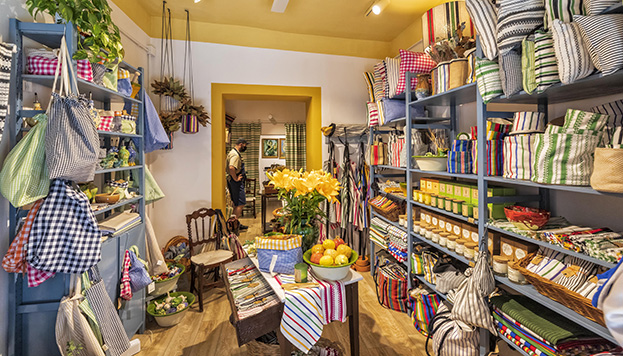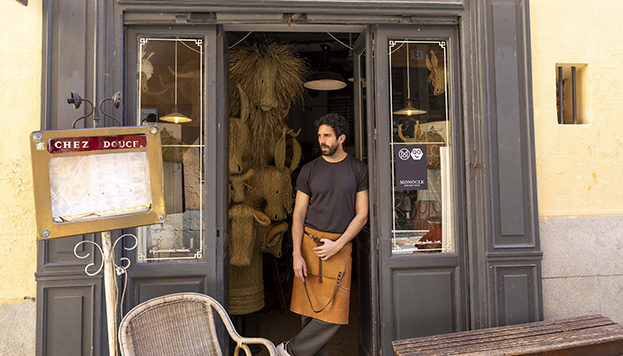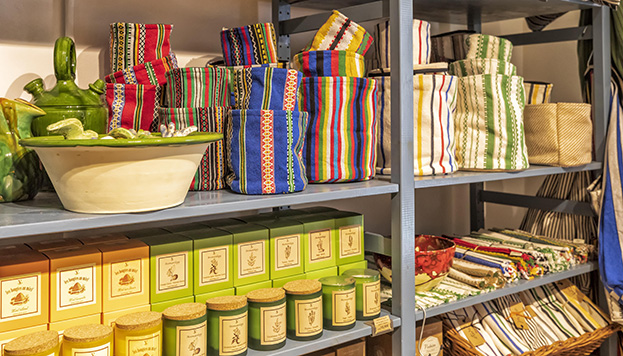
Eturel (© Álvaro López del Cerro).
Back in the day, Madrid was home to guilds for artisan weavers and basket makers who worked with natural fibres. Today we can find craftsmen, some of whom come from historical Madrid-born families, who share this passion for former trades in these current times.

Javier S. Medina (© Álvaro López del Cerro).
A map of old Madrid can be traced by the trades its citizens practised in times past. Found throughout the city, the guilds of the Middle Ages were professional associations formed by workers who shared the same vocation. There were the tanners, the cutlers… and the weavers. After the latter a street close to Plaza Mayor was named (Calle de Esparteros), the very one where their guild was established. The reason behind this location was that it was once home to the vineyards that belonged to the village of Fuencarral. After they disappeared, the land was occupied by Valencians, who would weave mats from esparto grass for the houses of those who lived in the town. Natural materials were also the product of choice of basket weavers, rope-makers and cable-makers, who used hemp to craft harnesses for animals. Today, many contemporary artisans use the same materials to make the most imaginative decorative items, accessories and tools for every day use.

Javier S. Medina (© Álvaro López del Cerro).
Bamboo, wicker and rattan are the materials that Javier Sánchez Medina, the Extremadura-born artisan who settled in Madrid, uses to restore items and craft his internationally acclaimed products. Here everything is handmade, from mirrors in the shapes of flowers, suns and stars, which hang on the walls of many of the city´s trendy restaurants, to the popular faux animal heads that the designer himself refers to as animal-friendly trophies. His portfolio boasts bulls, reindeers, buffalos, rhinos, black sheep, and more, all of which are woven from braided esparto and sown together with twine. Javier uses only traditional, environmentally friendly methods in line with former production methods. His studio, located in a quiet corner of the neighbourhood of Malasaña, is crammed with old tools he has given a new life. Here he also runs courses for people to experience first-hand the passion of this artisan trade. His admirers include New York interior designer Nate Berkus and actress Sarah Jessica Parker, who stumbled upon his workshop on a flying visit to Madrid and fell in love with his pieces.

Eturel (© Álvaro López del Cerro).
“I strive to bring back what we know as village life: chatting to neighbours on sunny afternoons, both the charm and the harshness of the countryside and hours that pass by without haste. And I do so with the fabric that has surrounded me my entire life.” These are the words of Eduardo Rodríguez Turel, who has pursued a vocation that has taken him back to his very origins: the village of Tembleque in Toledo. In actual fact, his store and workshop in El Rastro flea market in Madrid evokes everything rural. He opts for sturdy, natural raw materials steeped in tradition, such as hessian fabric woven from hemp or jute, alpujarra – a very resistant fabric of Moorish origin from the region of the same name, which typically has a striped pattern – and canvas, a robust and long-lasting fabric known for withstanding high temperatures. His range of shoulder bags, baskets, shoppers, cushions, aprons, sacks, and bread bags is completely irresistible.

Espartería Juan Sánchez (© Álvaro López del Cerro).
At the helm of this business is the third generation of a family of artisans who, in addition to restoring chairs and fitting blinds, uses esparto grass to craft caracoleras, or baskets for snail pickers, in addition to fireplace fans, saddlebags, and bottle holders. This shop is one of a kind. And if you´re still not convinced, in the words of Juan himself: “The profession of weaving is disappearing, especially in big cities. Esparto grass is a difficult material to work with and for many artisans it’s not worth the trouble. For this reason, there are only a handful of us who have seen this vocation through to the 21st century.” In addition to this raw material, the workshop also uses wicker, heather, reeds, bamboo, hemp, rattan, bulrush, and agave. The resulting items include straw hats, plant hangers, zinc buckets, cowbells, walking sticks, earthenware pitchers, and wineskins, and other extraordinary rustic pieces with an authentic rural touch.

Casa Hernanz (© Álvaro López del Cerro).
Today, this rope manufacturer founded in the year 1845, still crafts and sells esparto accessories, but it has also made the props for various Hollywood motion pictures, including Gladiator. Nowadays, its espadrilles are its star product. This classic form of footwear – traditionally worn by workers to protect their feet – was made fashionable by Yves Saint Laurent. Clients flock from all over the world to this historical store on Calle de Toledo to buy them. Their other items include a range of rope products, wicker baskets, decorative netting, sacks woven from jute and agave, and rustic fabrics made from natural fibres, including linen, cotton and hessian, which are sold by the metre. Jesús, the great-nephew of José and the current owner, and his children welcome customers from behind the shop counter. Here passion for this authentic profession lives on: “Customers who visit us leave with something more than our products; they go home with the wisdom of a family dedicated to their business, satisfaction at finding something truly genuine, and the aroma of hand-woven jute and esparto grass”.